-

新人教版高中英语选修2Unit 2 Learning about Language教学设计
The activity theme of this section is to design various activities around the key words in the first text. Therefore, the activities require students to pay attention to the spelling of words. On the other hand, let students grasp the meaning of words more accurately through sentences and short texts. This kind of teaching design also helps to improve the ability of using English thinking.1. Cultivating students' ability to use word formation to induce and memorize vocabulary, and the ability to use lexical chunks to express meaning.2. Guide the students to think independently and use the correct form of words to complete sentences3. Cultivate students' habit of using lexical chunks to express language completely, guide students to draw words in sentences quickly, pay attention to word collocation, so as to accumulate more authentic expressions4. Instruct students to create sentences with the chunks.1. Enable students to use the language points in the real situation or specific contexts flexibly and appropriately.2. Guiding the Ss to use unit topic words and the sentence patterns in a richer context.Step1: Think of a word that best fits each definition.1. to remember sth2.to accept, admit, or recognize sth or the truth/existence of sth3. the process of changing sth or yourself to suit a new situation4 .to make sb feel less worried or unhappy5. a strong desire to achieve sth

新人教版高中英语选修2Unit 2 Reading and thinking教学设计
Her tutor told her to acknowledge __________ other people had said if she cited their ideas, and advised her _______(read) lots of information in order to form __________wise opinion of her own.Now halfway __________ her exchange year, Xie Lei felt much more at home in the UK. She said __________ (engage) in British culture had helped and that she had been__________ (involve) in social activities. She also said while learning about business, she was acting as a cultural messenger __________(build) a bridge between the two countries. keys:Xie Lei, a 19yearold Chinese student, said goodbye to her family and friends in China and boarded (board) a plane for London six months ago in order to get a business qualification. She was ambitious(ambition) to set up a business after graduation. It was the first time that she had left (leave) home.At first, Xie Lei had to adapt to life in a different country. She chose to live with a host family, who can help with her adaptation (adapt) to the new culture. When she missed home, she felt comforted (comfort) to have a second family. Also Xie Lei had to satisfy academic requirements. Her tutor told her to acknowledge what other people had said if she cited their ideas, and advised her to read lots of information in order to form a wise opinion of her own.Now halfway through her exchange year, Xie Lei felt much more at home in the UK. She said engaging (engage) in British culture had helped and that she had been involved (involve) in social activities. She also said while learning about business, she was acting as a cultural messenger building a bridge between the two countries.

新人教版高中英语选修2Unit 3 Reading for writing教学设计
The theme of this part is to write an article about healthy diet. Through reading and writing activities, students can accumulate knowledge about healthy diet, deepen their understanding of the theme of healthy diet, and reflect on their own eating habits. This text describes the basic principles of healthy diet. The author uses data analysis, definition, comparison, examples and other methods. It also provides a demonstration of the use of conjunctions, which provides important information reference for students to complete the next collaborative task, writing skills, vivid language materials and expressions.1. Teach Ss to learn and skillfully use the new words learned from the text.2. Develop students’ ability to understand, extract and summarize information.3. Guide students to understand the theme of healthy diet and reflect on their own eating habits.4. To guide students to analyze and understand the reading discourse from the aspects of theme content, writing structure, language expression, etc., 5. Enable Ss to write in combination with relevant topics and opinions, and to talk about their eating habits.1. Guide students to analyze and understand the reading discourse from the aspects of theme content, writing structure, language expression, etc.2. Enable them to write in combination with relevant topics and opinions, and to talk about their eating habits.3. Guide the students to use the cohesive words correctly, strengthen the textual cohesion, and make the expression fluent and the thinking clear.Step1: Warming upbrainstorm some healthy eating habits.1.Eat slowly.2.Don’t eat too much fat or sugar.3.Eat healthy food.4.Have a balanced diet.Step2: Read the passage and then sum up the main idea of each paragraph.

新人教版高中英语选修2Unit 2 Using langauge-Listening教学设计
? B: Absolutely! Getting involved with Chinese cultural activities there definitely helped a lot. I got to practice my Chinese on a daily basis, and I could learn how native Chinese speakers spoke.? A: What do you feel is your biggest achievement?? B: Learning Chinese characters! I have learnt about 1,500 so far. When I first started, I didn't think it was even going to be possible to learn so many, but now I find that I can read signs, menus, and even some easy newspaper articles.? A: What are you most keen on?? B: I've really become keen on learning more about the Chinese culture, in particular Chinese calligraphy. As I have learnt Chinese characters, I have developed a great appreciation for their meaning. I want to explore Chinese characters by learning how to write them in a more beautiful way. ? A: Finally, what do you want to say to anyone interested in learning Chinese?? I have really become keen on learning more about the Chinese culture, in particular Chinese Calligraphy. As I have learnt Chinese character, I have developed a great appreciation for their meaning. I want to explore Chinese characters by learning how to write them in a more beautiful way.? A: Finally, what do you want to say to anyone interested in learning Chinese?? B: I'd say, give it a shot! While some aspects may be difficult, it is quite rewarding and you will be happy that you tried.? A: Thanks for your time. ? B:You're welcome.

新人教版高中英语选修2Unit 3 Using langauge-Listening教学设计
1. How is Hunan cuisine somewhat different from Sichuan cuisine?The heat in Sichuan cuisine comes from chilies and Sichuan peppercorns. Human cuisine is often hotter and the heat comes from just chilies.2.What are the reasons why Hunan people like spicy food?Because they are a bold people. But many Chinese people think that hot food helps them overcome the effects of rainy or wet weather.3.Why do so many people love steamed fish head covered with chilies?People love it because the meat is quite tender and there are very few small bones.4.Why does Tingting recommend bridge tofu instead of dry pot duck with golden buns?Because bridge tofu has a lighter taste.5 .Why is red braised pork the most famous dish?Because Chairman Mao was from Hunan, and this was his favorite food.Step 5: Instruct students to make a short presentation to the class about your choice. Use the example and useful phrases below to help them.? In groups of three, discuss what types of restaurant you would like to take a foreign visitor to, and why. Then take turns role-playing taking your foreign guest to the restaurant you have chosen. One of you should act as the foreign guest, one as the Chinese host, and one as the waiter or waitress. You may start like this:? EXAMPLE? A: I really love spicy food, so what dish would you recommend?? B: I suggest Mapo tofu.? A: Really ? what's that?

新人教版高中英语选修2Unit 4 Learning about Language教学设计
This section guides students to pay attention to the typical context of vocabulary use, helps students accumulate vocabulary around the key vocabulary of this unit, and uses the learned words and word chunks in different contexts to deeply understand their meaning and usage, so as to achieve the purpose of review and consolidation.The teaching design activities aim to guide students to pay attention to the typical context in which the target vocabulary is used, as well as the common vocabulary used in collocation, so that students can complete the sentence with correct words. In terms of vocabulary learning strategies, this unit focuses on cultivating students' ability to pay attention to collocation of words and to use word blocks to express meaning.For vocabulary learning, it is not enough just to know the meaning of a single word, but the most important thing is to master the common collocations of words, namely word blocks.Teachers should timely guide students to summarize common vocabulary collocation, such as verb and noun collocation, verb and preposition collocation, preposition and noun collocation, and so on.1. Guide students to understand and consolidate the meaning and usage of the vocabulary in the context, 2. Guide the students to use the unit topic vocabulary in a richer context3. Let the students sort out and accumulate the accumulated vocabulary, establishes the semantic connection between the vocabulary,4. Enable students to understand and master the vocabulary more effectivelyGuiding the Ss to use unit topic words and the sentence patterns in a richer context.

新人教版高中英语选修2Unit 4 Reading for writing教学设计
假定你是英国的Jack,打算来中国旅行,请你给你的中国笔友李华写一封信,要点如下:1.你的旅行计划:北京→泰山→杭州;2.征求建议并询问他是否愿意充当你的导游。注意:1.词数80左右(开头和结尾已给出,不计入总词数);2.可以适当增加细节,以使行文连贯。参考词汇:故宫 the Forbidden City;泰山 Mount TaiDear Li Hua,I'm glad to tell you that 'm going to visit China.First,I am planning to visit Beijing,the capitalof China,where I am looking forward to enjoying the Great Wall,the Forbidden City and somebeautiful parks.Then I intend to go to visit Mount Tai in Shandong Province.I've heard that it is one ofthe most famous mountains in China and I can't wait to enjoy the amazing sunrise there.After that,I amalso going to Hangzhou.It is said that it is a beautiful modern city with breathtaking natural sights,among which the West Lake is a well- known tourist attraction.What do you think of my travel plan? Will you act as my guide? Hope to hear from you soon.

新人教版高中英语选修2Unit 4 Using langauge-Listening教学设计
The theme of the listening section is " talking about scenery and culture along a journey."The part is designed to further lead the students to understand Canadian natural geography and social environment, and integrated into the cultural contrast by mentioning the long train journey from Beijing to Moscow routes. On this basis, the part activates students related travel experience, lets the student serial dialogue, guides the student to explore further the pleasure and meaning of the long journey, and Chinese and foreign cultural comparison.The part also provides a framework for the continuation of the dialogue, which is designed to provide a framework for students to successfully complete their oral expressions, and to incorporate an important trading strategy to end the dialogue naturally.1. Help students to understand and master some common English idioms in the context, and experience the expression effect of English idioms.2. Guide the students to understand the identity of different people in the listening context, and finish the dialogue according to their own experience.3. Instruct the students to use appropriate language to express surprise and curiosity about space and place in the dialogue, and master the oral strategy of ending the dialogue naturally.1. Instruct students to grasp the key information and important details of the dialogue.2. Instruct students to conduct a similar talk on the relevant topic.

新人教版高中英语选修2Unit 5 Learning about Language教学设计
The purpose of this section of vocabulary exercises is to consolidate the key words in the first part of the reading text, let the students write the words according to the English definition, and focus on the detection of the meaning and spelling of the new words. The teaching design includes use English definition to explain words, which is conducive to improving students' interest in vocabulary learning, cultivating their sense of English language and thinking in English, and making students willing to use this method to better grasp the meaning of words, expand their vocabulary, and improve their ability of vocabulary application. Besides, the design offers more context including sentences and short passage for students to practice words flexibly.1. Guide students to understand and consolidate the meaning and usage of the vocabulary in the context, 2. Guide the students to use the unit topic vocabulary in a richer context3. Let the students sort out and accumulate the accumulated vocabulary, establishes the semantic connection between the vocabulary,4. Enable students to understand and master the vocabulary more effectivelyGuiding the Ss to use unit topic words and the sentence patterns in a richer context.Step1: Read the passage about chemical burns and fill in the blanks with the correct forms of the words in the box.

新人教版高中英语选修2Unit 5 Reading and thinking教学设计
The theme of this activity is to learn the first aid knowledge of burns. Burns is common in life, but there are some misunderstandings in manual treatment. This activity provides students with correct first aid methods, so as not to take them for granted in an emergency. This section guides students to analyze the causes of scald and help students avoid such things. From the perspective of text structure and collaborative features, the text is expository. Expository, with explanation as the main way of expression, transmits knowledge and information to readers by analyzing concepts and elaborating examples. This text arranges the information in logical order, clearly presents three parts of the content through the subtitle, accurately describes the causes, types, characteristics and first aid measures of burns, and some paragraphs use topic sentences to summarize the main idea, and the level is very clear.1. Guide students to understand the causes, types, characteristics and first aid methods of burns, through reading2. Enhance students’ ability to deal withburnss and their awareness of burns prevention3. Enable students to improve the ability to judge the types of texts accurately and to master the characteristics and writing techniques of expository texts.Guide students to understand the causes, types, characteristics and first aid methods of burns, through readingStep1: Lead in by discussing the related topic:1. What first-aid techniques do you know of ?CPR; mouth to mouth artificial respiration; the Heimlich Manoeuvre

新人教版高中英语选修2Unit 5 Using langauge-Listening教学设计
The theme of this section is to learn how to make emergency calls. Students should learn how to make emergency calls not only in China, but also in foreign countries in English, so that they can be prepared for future situations outside the home.The emergency telephone number is a vital hotline, which should be the most clear, rapid and effective communication with the acute operator.This section helps students to understand the emergency calls in some countries and the precautions for making emergency calls. Through the study of this section, students can accumulate common expressions and sentence patterns in this context. 1.Help students accumulate emergency telephone numbers in different countries and learn more about first aid2.Guide the students to understand the contents and instructions of the telephone, grasp the characteristics of the emergency telephone and the requirements of the emergency telephone.3.Guide students to understand the first aid instructions of the operators.4.Enable Ss to make simulated emergency calls with their partners in the language they have learned1. Instruct students to grasp the key information and important details of the dialogue.2. Instruct students to conduct a similar talk on the relevant topic.Step1:Look and discuss:Match the pictures below to the medical emergencies, and then discuss the questions in groups.
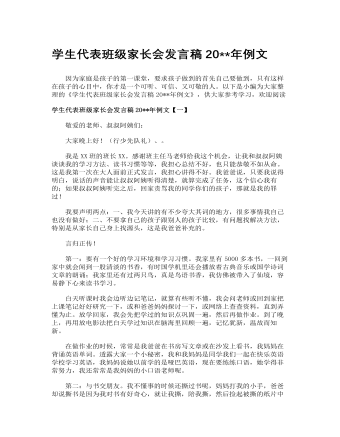
学生代表班级家长会发言稿2023年例文
敬爱的老师、叔叔阿姨们: 大家晚上好!(行少先队礼)、。 我是XX班的班长XX。感谢班主任马老师给我这个机会,让我和叔叔阿姨谈谈我的学习方法、读书习惯等等,我担心总结不好,也只能恭敬不如从命。这是我第一次在大人面前正式发言,我担心讲得不好。我爸爸说,只要我说得明白,说话的声音能让叔叔阿姨听得清楚,就算完成了任务,这个信心我有的;如果叔叔阿姨听完之后,回家责骂我的同学你们的孩子,那就是我的罪过! 我要声明两点:一、我今天讲的有不少夸大其词的地方,很多事情我自己也没有做好;二、不要拿自己的孩子跟别人的孩子比较,有问题找解决方法,特别是从家长自己身上找源头,这是我爸爸补充的。 言归正传! 第一:要有一个好的学习环境和学习习惯。我家里有5000多本书,一回到家中就会闻到一股清淡的书香,有时国学机里还会播放着古典音乐或国学诗词文章的朗诵;我家里还有过两只鸟,真是鸟语书香,我仿佛被带入了仙境,容易静下心来读书学习。 白天听课时我会边听边记笔记,就算有些听不懂,我会问老师或回到家把上课笔记好好研究一下,或和爸爸妈妈探讨一下,或网络上查查资料,直到弄懂为止。放学回家,我会先把学过的知识点巩固一遍,然后再做作业。到了晚上,再用放电影法把白天学过知识在脑海里回顾一遍,记忆犹新,温故而知新。
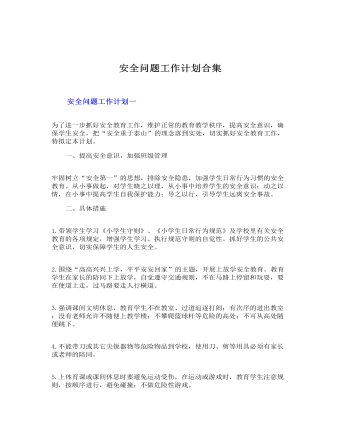
安全问题工作计划合集
一、提高安全意识,加强班级管理 牢固树立“安全第一”的思想,排除安全隐患,加强学生日常行为习惯的安全教育。从小事做起,对学生晓之以理,从小事中培养学生的安全意识;动之以情,在小事中提高学生自我保护能力;导之以行,引导学生远离安全事故。 二、具体措施 1.带领学生学习《小学生守则》、《小学生日常行为规范》及学校里有关安全教育的各项规定,增强学生学习、执行规范守则的自觉性。抓好学生的公共安全意识,切实保障学生的人生安全。
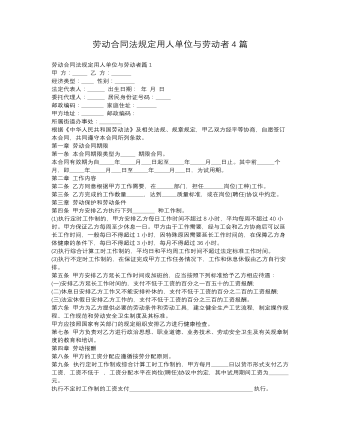
劳动合同法规定用人单位与劳动者4篇
第二章 工作内容第二条 乙方同意根据甲方工作需要,在_______部门,担任________岗位(工种)工作。第三条 乙方完成的工作数量_______,达到______质量标准,或在岗位(聘任)协议中约定。第三章 劳动保护和劳动条件第四条 甲方安排乙方执行下列_________ 种工作制。(1)执行定时工作制的,甲方安排乙方每日工作时间不超过8小时,平均每周不超过40小时。甲方保证乙方每周至少休息一日。甲方由于工作需要,经与工会和乙方协商后可以延长工作时间,一般每日不得超过1小时,因特殊原因需要延长工作时间的,在保障乙方身体健康的条件下,每日不得超过3小时,每月不得超过36小时。(2)执行综合计算工时工作制的,平均日和平均周工作时间不超过法定标准工作时间。(3)执行不定时工作制的,在保证完成甲方工作任务情况下,工作和休息休假由乙方自行安排。
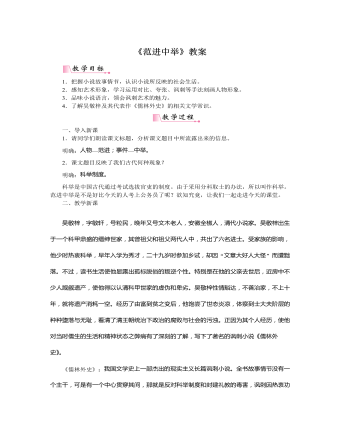
部编版语文九年级上册《范进中举》教案
目标导学一:了解作者,了解作品吴敬梓,字敏轩,号粒民,晚年又号文木老人,安徽全椒人,清代小说家。吴敬梓出生于一个科甲鼎盛的缙绅世家,其曾祖父和祖父两代人中,共出了六名进士。受家族的影响,他少时热衷科举,早年入学为秀才,二十九岁时参加乡试,却因“文章大好人大怪”而遭黜落。不过,读书生活使他显露出孤标脱俗的叛逆个性。特别是在他的父亲去世后,近房中不少人觊觎遗产,使他得以认清科甲世家的虚伪和卑劣。吴敬梓性情豁达,不善治家,不上十年,就将遗产消耗一空。经历了由富到贫之变后,他饱尝了世态炎凉,体察到士大夫阶层的种种堕落与无耻,看清了清王朝统治下政治的腐败与社会的污浊。正因为其个人经历,使他对当时儒生的生活和精神状态之弊病有了深刻的了解,写下了著名的讽刺小说《儒林外史》。

部编版语文九年级上册《我爱这土地》教案
目标导学四:赏析作品,把握诗歌艺术特色1.这首诗在结构上共分两节,请简要说说两节诗歌各有什么特点及它们之间的内在联系。明确:诗的第一节是从虚拟的视角,即从鸟儿的视角去想象,去表现鸟儿对土地的忠诚与挚爱,显得形象含蓄;第二节却换成实写的视角,即从作者自我的视角去实写自己“常含泪水的眼睛”,倾诉自己对土地的“深沉”之爱,是直抒胸臆。这样,虚境和实境的结合与对应,构筑了全诗内在完整的艺术空间;结果与原因的关联与对照,又构成了支撑全诗的内在逻辑结构。此外,从手法特点上看,第一节用的是比,是想象的境界;第二节则是直抒胸臆的写实。全诗由前面蒙太奇镜头式的画面暗示转到了后面作者的直接指点,以一个强有力的情感抒发结束了全篇,从而把注意力引到一个浓郁的情感氛围中,再一次感受到作者对土地的忠贞与挚爱。
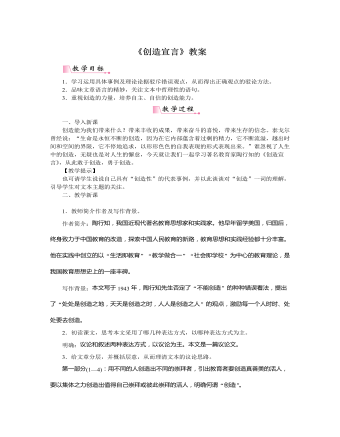
部编版语文九年级上册《创造宣言》教案
1.学习运用具体事例及理论论据驳斥错误观点,从而得出正确观点的驳论方法。2.品味文章语言的精妙,关注文本中哲理性的语句。3.重视创造的力量,培养自主、自信的创造能力。一、导入新课创造能为我们带来什么?带来丰收的成果,带来奋斗的喜悦,带来生存的信念。泰戈尔曾经说:“生命是永恒不断的创造,因为在它内部蕴含着过剩的精力,它不断流溢,越出时间和空间的界限,它不停地追求,以形形色色的自我表现的形式表现出来。”谁忽视了人生中的创造,无疑也是对人生的懈怠,今天就让我们一起学习著名教育家陶行知的《创造宣言》,从此敢于创造,勇于创造。【教学提示】也可请学生说说自己具有“创造性”的代表事例,并以此谈谈对“创造”一词的理解,引导学生对文本主题的关注。二、教学新课目标导学一:初读课文,整体感知1.教师简介作者及写作背景。
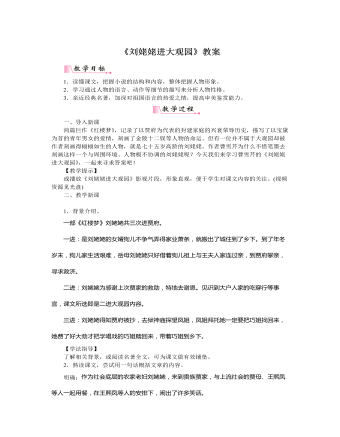
部编版语文九年级上册《刘姥姥进大观园》教案
2.这篇课文细致地描写了各具情态的笑,给人留下了难忘的印象。请说说主要人物的笑有什么不同,反映了他们怎样的性格特点。明确:凤姐、鸳鸯的笑而不露,反映出她们善于计谋,爱耍小手段、取笑、捉弄人的性格特点;史湘云“掌不住,一口茶都喷出来”,反映出她的率真、爽朗、不受拘束的性格;林黛玉“笑岔了气,伏着桌子只叫‘嗳哟!’”,可见她的笑是极力控制,反映出她含蓄、有教养而又谨慎的性格;宝玉笑时钻到贾母的怀里,反映出他的天真、孩子气,也写出了贾母爱孙之心;探春手里的“茶碗都合在迎春身上”,反映了她率真、爽朗、不受拘束的性格特点,也可以看出她要强的个性;惜春笑得肚子疼,让奶母给揉肠子,反映出她娇气、孩子气;“王夫人笑的用手指着凤姐儿,只说不出话来”,写出王夫人已知道是凤姐导演的,但又不便张扬的心理,也保持了雍容与尊贵。
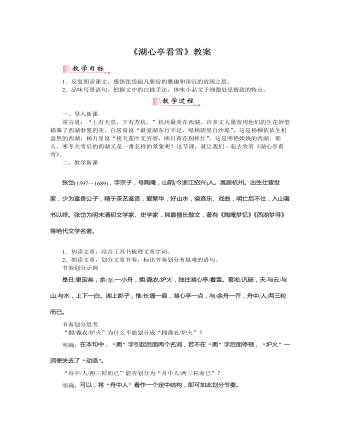
部编版语文九年级上册《湖心亭看雪》教案
一、导入新课常言道:“上有天堂,下有苏杭。”杭州最美在西湖。许多文人墨客用他们的生花妙笔描摹了西湖春夏的美。白居易说“最爱湖东行不足,绿杨阴里白沙堤”,这是杨柳依依生机盎然的西湖;杨万里说“接天莲叶无穷碧,映日荷花别样红”,这是明艳妖娆的西湖。那么,寒冬大雪后的西湖又是一番怎样的景象呢?这节课,就让我们一起去欣赏《湖心亭看雪》。二、教学新课目标导学一:认识作者,了解作品张岱(1597—1689),字宗子,号陶庵,山阴(今浙江绍兴)人。寓居杭州。出生仕宦世家,少为富贵公子,精于茶艺鉴赏,爱繁华,好山水,晓音乐、戏曲,明亡后不仕,入山著书以终。张岱为明末清初文学家、史学家,其最擅长散文,著有《陶庵梦忆》《西湖梦寻》等绝代文学名著。目标导学二:朗读训练,通文顺字1.初读文章,结合工具书梳理文章字词。2.朗读文章,划分文章节奏,标出节奏划分有疑难的语句。节奏划分示例
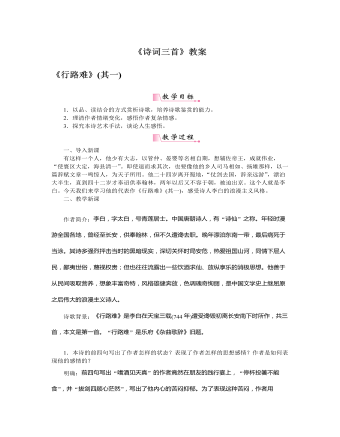
部编版语文九年级上册《诗词三首》教案
一、导入新课有这样一个人,他少有大志,以管仲、晏婴等名相自期,想辅佐帝王,成就伟业,“使寰区大定,海县清一”。即使退而求其次,也要像他的乡人司马相如、扬雄那样,以一篇辞赋文章一鸣惊人,为天子所用。他二十四岁离开蜀地,“仗剑去国,辞亲远游”,漂泊大半生,直到四十二岁才奉诏供奉翰林,两年以后又不容于朝,被迫出京。这个人就是李白。今天我们来学习他的代表作《行路难》(其一),感受诗人李白的浪漫主义风格。二、教学新课目标导学一:认识作者,了解写作背景作者简介:李白,字太白,号青莲居士。中国唐朝诗人,有“诗仙”之称。年轻时漫游全国各地,曾经至长安,供奉翰林,但不久遭谗去职。晚年漂泊东南一带,最后病死于当涂。其诗多强烈抨击当时的黑暗现实,深切关怀时局安危,热爱祖国山河,同情下层人民,鄙夷世俗,蔑视权贵;但也往往流露出一些饮酒求仙、放纵享乐的消极思想。他善于从民间吸取营养,想象丰富奇特,风格雄健奔放,色调瑰奇绚丽,是中国文学史上继屈原之后伟大的浪漫主义诗人。

